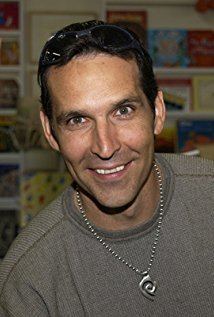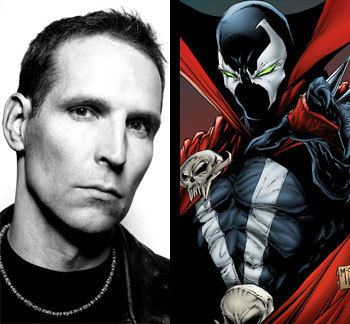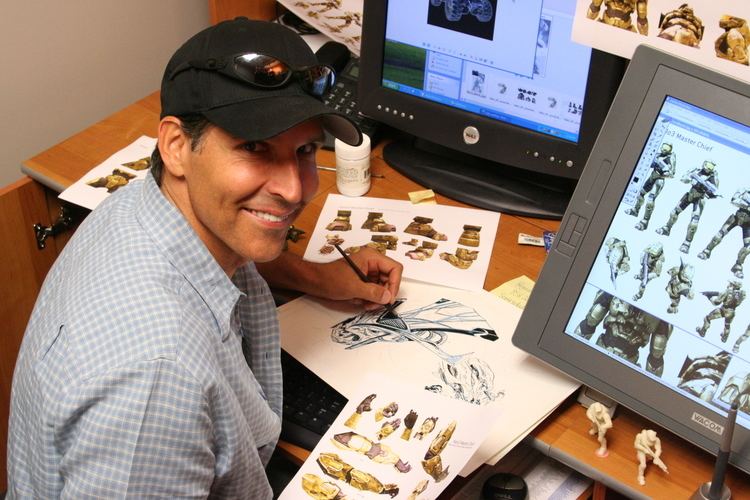Nationality Canadian Name Todd McFarlane | Role Cartoonist Spouse Wanda McFarlane (m. 1985) | |
 | ||
Awards Inkpot Award 1992National Cartoonists Society Award 1992National Football League Artist of the Year 2005 Books Spider-Man, Outlaw Animation Movies and TV shows Todd McFarlane's Spawn, Spawn, Spawn: The Animation, Spawn 3: The Ultimate, Spawn 2 Similar People Profiles | ||
Todd McFarlane's Significant Contribution to Comics
Todd McFarlane (; born March 16, 1961) is a Canadian-American comic book creator and entrepreneur, best known for his work on The Amazing Spider-Man and the horror-fantasy series Spawn.
Contents
- Todd McFarlanes Significant Contribution to Comics
- Spider man to spawn how todd mcfarlane became the biggest comic book artist ever blueprint
- Early life
- Early work DC and Marvel
- The Amazing Spider Man
- New Spider Man title
- Image Comics
- McFarlane Entertainment
- Sports
- Other media
- Media about Todd McFarlane
- Legal issues
- Awards and recognition
- Personal life
- References

In the late 1980s and early 1990s, McFarlane became a comic book superstar due to his work on Marvel Comics' Spider-Man franchise, on which he was the artist to draw the first full appearances of the supervillain Venom. In 1992, he helped form Image Comics, pulling the occult anti-hero character Spawn from his high school portfolio and updating him for the 1990s. Spawn was a popular hero in the 1990s and encouraged a trend in creator-owned comic book properties.

Since leaving inking duties on Spawn with issue No. 70 (February 1998), McFarlane has illustrated comic books less often, focusing on entrepreneurial efforts, such as McFarlane Toys and Todd McFarlane Entertainment, a film and animation studio. In September 2006, it was announced that McFarlane would be the Art Director of the newly formed 38 Studios, formerly Green Monster Games, founded by major league baseball pitcher Curt Schilling. McFarlane used to be a co-owner of the National Hockey League's Edmonton Oilers before selling his shares to Daryl Katz. He is also a high-profile collector of record-breaking baseballs.

Spider man to spawn how todd mcfarlane became the biggest comic book artist ever blueprint
Early life

Todd McFarlane was born on March 16, 1961 in Calgary, Alberta, Canada to Bob and Sherlee McFarlane. He has two brothers, Curtis and Derek. Bob worked in the printing business, which led him to take work where he could find it, and as a result, during McFarlane's childhood, the family lived in thirty different places from Alberta to California.

McFarlane began drawing as a hobby at an early age, and developed an interest in comics, acquiring as many as he could, and learning to draw from them. He was a fan of comics creators such as John Byrne, Jack Kirby, Frank Miller and George Pérez, as well as the writing of Alan Moore. (John Parker of ComicsAlliance has also noted the influence of Walt Simonson in McFarlane's work.) McFarlane created the character Spawn when he was 16, and spent "countless hours" perfecting the appearance of each component of the character's visual design.

One day while in the twelfth grade at Calgary's Sir Winston Churchill High School, McFarlane, working as a groundskeeper for the Calgary Cardinals, was standing in the bleachers when a 13-year-old ninth grader sitting near him named Wanda began flirting with him. The two began dating, over the objections of Wanda's father, who thought she was too young for him, though in time McFarlane won him over.
Right after high school, McFarlane attended baseball tryouts at Gonzaga University. Despite being a good fielder and fast, he was not a good hitter. Moreover, he could not afford Gonzaga, so he attended Spokane Falls Community College for a year, his relationship with Wanda developing into a long-distance one. In 1981 McFarlane began attending Eastern Washington University (EWU) on a baseball scholarship, studying as part of a self-designed program for graphics and art. His practical goal was to join his father in the printing business in Calgary, Alberta, though his dream was always to be a comic book creator. He worked part-time on campus as a janitor in the school's administration building, as his scholarship required an on-campus job, and also worked weekends at a comics ship called the Comic Rack, devoting a couple of hours late at night to practice his comics art.
He sought to play baseball professionally after graduation, but suffered a serious ankle injury in his junior year during a game with arch rivals Washington State University. He subsequently focused on drawing, working at the comic book store to pay for the rest of his education, and living in a trailer park in Cheney, Washington with Wanda, who had moved to the area to be with him and attend EWU as well. In 1984, a year after his injury, McFarlane's final chance to play for the big leagues came when he tried out with the Toronto Blue Jays' farm team in Medicine Hat, Alberta, but ended up being ranked last on the roster, ending his professional baseball prospects. McFarlane graduated with Bachelor's degree that same year. He stayed in Spokane while Wanda finished her degree.
Early work, DC, and Marvel
While still in college, McFarlane began sending 30-40 packages of submissions each month to comics editors, totaling over 700 submissions after a year and a half, most of which were in the form of pinups. Half resulted in no response, while the other half resulted in rejection letters, though he received some constructive criticism from a few editors. One of them, DC Comics' Sal Amendola, gave McFarlane a dummy script in order to gauge McFarlane's page-to-page storytelling ability. Amendola's advice that McFarlane's submissions needed to focus page-to-page stories rather than pinups led McFarlane to create a five-page Coyote sample that he initially sent to Uncanny X-Men editor Ann Nocenti at Marvel Comics, who passed it along to Archie Goodwin and Jo Duffy, the editors of the Marvel imprint Epic Comics, which published Coyote. They in turn passed it onto Coyote creator Steve Englehart, who called McFarlane to offer McFarlane his first comic job, a 1984 backup story in Coyote.
McFarlane soon began drawing for both DC and Marvel, with his first major body of work being a two-year run (1985–1987) on DC's Infinity, Inc. In 1987, McFarlane illustrated the latter three issues of Detective Comics' four-issue "Batman: Year Two" storyline. From there, he moved to Marvel's Incredible Hulk, which he drew from 1987 to 1988, working with writer Peter David.
The Amazing Spider-Man
In 1988, McFarlane joined writer David Michelinie on Marvel's The Amazing Spider-Man, beginning with issue 298, drawing the preliminary sketch for that cover's image on the back of one of his Incredible Hulk pages. McFarlane garnered notice for the more dynamic poses in which he depicted Spider-Man's aerial web-swinging, his enlarging of the eyes on the character's mask, and greater detail in which he rendered his artwork. In particular was the elaborate detail he gave to Spider-Man's webbing. Whereas it had essentially been rendered as a series of X's between two lines, McFarlane embellished it by detailing far more individual strands, which came to be dubbed "spaghetti webbing". McFarlane was also the first artist to draw the first, full appearance of Eddie Brock, the original incarnation of the villain Venom. He has been credited as the character's co-creator, though this has been a topic of dispute within the comic book industry. (See Eddie Brock: Creation and conception.)
McFarlane's work on Amazing Spider-Man made him an industry superstar. His cover art for Amazing Spider-Man No. 313, for which he was originally paid $700 in 1989, for example, would later sell for $71,200 in 2010. Despite this, he became increasingly dissatisfied with the lack of control over his own work, as he wanted more say in the direction of storylines. He began to miss deadlines, requiring guest artists to fill-in for him on some issues. In 1990, after a 28-issue run of Amazing Spider-Man, McFarlane told editor Jim Salicrup that he wanted to write his own stories, and would be leaving the book with issue No. 328, which was part of that year's company-wide "Acts of Vengeance" crossover storyline. In July 2012 the original artwork to that issue's cover, which features Spider-Man dispatching the Hulk, sold for a record-breaking $657,250 USD, the highest auction price ever for any piece of American comic book art. McFarlane was succeeded on Amazing Spider-Man by McFarlane's future fellow Image Comics co-founder Erik Larsen.
New Spider-Man title
Wanting to appease McFarlane, Marvel offered McFarlane a new, adjectiveless Spider-Man title for McFarlane to both write and draw. Spider-Man #1 (August 1990) sold 2.5 million copies, largely due to the variant covers that with which Marvel, seeking to capitalize on McFarlane's popularity, published the issue in order to encourage collectors into buying more than one edition. This practice was both a result of, and fueled, the comics speculator bubble of the 1990s, which would burst later that decade. McFarlane, unbeknownst to his parents at the time, was making about a million dollars a year. McFarlane wrote and illustrated 15 of the series' first 16 issues, many issues of which featured other popular Marvel characters such as Wolverine, and Ghost Rider in guest roles.
Despite his acclaim as an artist, fans found McFarlane's writing to be clumsy, unsophisticated and pretentious, and questioned the wisdom of allowing him to write a new Spider-Man title the first place. At the same time, editorial had problems with the dark tone of the stories McFarlane was telling, beginning with the inaugural "Torment" storyline, which depicted a more vicious version of the reptilian villain Lizard under the control of the voodoo priestess Calypso. Subsequent storylines such as "Masques" featured Spider-Man confronting the demonic Hobgoblin, while "Perceptions", which involved Spider-Man dealing with police corruption, child rape and murder (a hint of the work he would later do on Spawn), led some stores to refuse to stock the book. This created further tensions between McFarlane and editorial, which viewed Spider-Man an historically light-hearted character marketed to young readers. Editor Jim Salicrup in particular was required to make a number of compromises for McFarlane's work, including enforcing of McFarlane's minor costume changes across the entire line of other Spidey comics, placing limitations on his choice of villains for his stories, and dealing with strong disagreement on the handling of the character Mary Jane Watson. This strained McFarlane's relationship with Salicrup, which was expressed in the remarkable amount of public disagreement that appeared in the book's letters page. Eventually McFarlane's attention to his deadlines again began to waiver again, and he missed issue 15 of the title. His final issue on the book, #16 (November 1991), was part of a crossover storyline with X-Force, and led to creative clashes with new editor Danny Fingeroth. According to McFarlane and editor Tom DeFalco in the 2000 documentary The Devil You Know: Inside the Mind of Todd McFarlane, among the examples of the issues that prompted his departure were editorial's censorship of a panel in that issue in which the character Juggernaut was graphically stabbed in the eye with a sword. DeFalco supported the editing of the panel, calling it "inappropriate", while McFarlane called this "lunacy", arguing that such graphic visuals are commonplace in Marvel's books. Fed up with editorial interference, he left the company under something of a cloud. According to David Wallace of Comics Bulletin, "McFarlane's fifteen issues of Spider-Man are now (perhaps slightly unfairly) held up alongside the likes of X-Force as the epitome of everything that was wrong 1990s comics, and their cash-in approach to the then-booming speculator market precipitated the near-collapse of the industry."
Image Comics
McFarlane then teamed with five other popular artists to form Image Comics, an umbrella company under which each owned a publishing house. McFarlane's studio, Todd McFarlane Productions, published his creation, the occult-themed Spawn, written and drawn by McFarlane. It was Image's second release, following the release of Rob Liefeld's Youngblood the month prior. Upon its release in 1992, Spawn #1 (May 1992) sold 1.7 million copies, still a record for an independent comic book.
Responding to harsh criticism of his abilities as a writer, McFarlane hired acclaimed writers to guest-write issues #8–11, including Alan Moore, Neil Gaiman, Dave Sim, and Frank Miller. Subsequent writers he would hire on the series included Grant Morrison, Andrew Grossberg, and Tom Orzechowski. Greg Capullo penciled several issues as a guest artist, and became the regular penciler with #26, with McFarlane remaining as writer and inker until #70. The series continued to be a hit, and in 1993 Wizard declared Spawn "the best-selling comic on a consistent basis that is currently being published." Spawn is notable for being one of only two Image books that debuted during the company's 1992 launch, along with Erik Larsen's Savage Dragon, that continues to be published well into the late 2010s.
During Image's early years of operation, the company was subject to much industry criticism over aspects of his business practices, including late-shipped books, and its creators' emphasis of art over writing. One of these critics was McFarlane's former Hulk collaborator, writer Peter David. This came to a head during a public debate they participated in at Philadelphia's Comicfest convention in October 1993, which was moderated by artist George Pérez. McFarlane stated that Image was not being treated fairly by the media, and by David in particular. The three judges, Maggie Thompson, editor of the Comics Buyer's Guide, William Christensen of Wizard Press, and John Danovich of the magazine Hero Illustrated, voted 2–1 in favor of David, with Danovich voting the debate a tie.
By 1994, McFarlane ceased to be the regular writer and artist of Spawn, hiring writers such as Brian Holguin and David Hine, and artists such as Whilce Portacio, Angel Medina, Philip Tan, Szymon Kudranski, and Greg Capullo. McFarlane occasionally offered story input and inked covers. He would sporadically return as the interior artist for intermittent issues, and for a few years wrote it under a pseudonym in order to generate interest in the book by fostering the illusion that new talent was being brought into the book's production.
In 2006 McFarlane announced plans for Spawn/Batman with artist Greg Capullo, which McFarlane wrote and inked, which paid tribute to Jack Kirby. He also began taking an active role in comics publishing again, publishing collections of his Spawn comics in paperback form. Spawn Collection Volume 1 collecting issues 1–12 minus issue 9 (due to royalty issues with Neil Gaiman) and 10 (due to a vow he made to Sim) was released in December 2005. The first volume achieved moderate success, ranking 17 in the top one hundred graphic novels, with pre-order sales of 3,227 for that period.
In 2008, McFarlane returned to co-plot the series with returning writer Brian Holguin, with issue 185. Shrewd business decisions by McFarlane supported the book in the years following the comics speculator bubble's crash, but the series' sales have fluctuated, never matching the sales figures of the 1990s. Though it continues publication, its appearance on the Diamond Top 300 chart has been intermittent since the mid-2000s. Nonetheless, Shea Hennum of Paste magazine has observed of the series, "It’s a book that, for a time, people continued to buy because of the character instead of the creator. It has become as much of an institution as it is a comic.
Haunt, an ongoing series co-created by McFarlane and Robert Kirkman, was announced in 2007 and launched on October 7, 2009. The comic was initially written by Kirkman, penciled by Ryan Ottley, and inked by McFarlane, with Greg Capullo providing layouts. McFarlane also contributed pencils to some issues, and co-wrote issue 28, the series finale, with Joe Casey, who took over writing duties from Kirkman.
McFarlane Entertainment
Todd McFarlane Productions published multiple Spawn spin-offs and mini-series. McFarlane increasingly concentrated his own personal attention to those other ventures, which resulted in irregular work as an illustrator. In 1994, McFarlane created a toy company, Todd Toys, initially to merchandise collectible action figures of the Spawn characters. In three months, the company sold more than 2.2 million of the action figures nationwide. After Mattel sent a cease-and-desist order on the basis of a male doll in Mattel's Barbie line named Todd, McFarlane changed the company name to McFarlane Toys. The company's line of figures quickly expanded to those of popular cultural icons, such as members of the band Kiss, characters from the film franchise Texas Chainsaw Massacre, TV series such as The X-Files, and sports figures such as Terrell Owens. In 1999, the company sold over 6 million action figures.
In 1996, McFarlane founded McFarlane Entertainment, a film and animation studio. In collaboration with New Line Cinema, it produced the 1997 Spawn film and a new Spawn movie, planned in 2008. Spawn, while critically panned, was a modest box office success, earning $54.8 million domestically, and almost $33 million worldwide, against a $40 million budget. McFarlane Entertainment also produced the animated series Todd McFarlane's Spawn, (featuring voice work by actor Keith David) which aired on HBO from 1997 until 1999. Ed Bark of The Dallas Morning News called the series a "very unpleasant viewing experience" and asked "why anyone would want to subject themselves to such a relentlessly grim, gruesome dehumanizing experience." Nonetheless, the animated series won a 1998 Primetime Emmy Award for Outstanding Achievement in Animation.
The studio produced a number of music videos and other animations, including:
On July 21, 2011 at San Diego Comic-Con International, McFarlane and Stan Lee debuted their new comic, Blood Red Dragon. The series is a collaboration with musician Yoshiki and stars a fictionalized version of him.
McFarlane and Boston Red Sox pitcher Curt Schilling formed the gaming studio 38 Studios (formerly Green Monster Games), in order to produce role-playing games, with McFarlane overseeing art direction. In February 2012, the company released its only title, Kingdoms of Amalur: Reckoning, a single-player action role-playing game that enjoyed great success, but by late May 2012, the company had ceased operation, due to financial difficulties for which it had filed for bankruptcy.
McFarlane was one of several artists to illustrate a variant cover for Kirkman's The Walking Dead No. 100, which was released July 11, 2012 at the San Diego Comic-Con.
Sports
McFarlane continues to be an avid baseball fan. In 1998, he paid $2.6 million USD at auction for the baseball that St. Louis Cardinals first baseman Mark McGwire hit for his then record-breaking 70th home run, and $175,000 for Sammy Sosa's 66th home run ball. In June 2003 McFarlane paid about $517,500 at auction for San Francisco Giants left fielder Barry Bonds' October 2001, record-breaking 73rd home run ball. The auction took place at the ESPN Zone in New York's Times Square and was featured live on SportsCenter. When asked by Time magazine's Michael Grunwald in a 2007 interview if he was interested in Bonds' record 756th career home run ball, McFarlane indicated that he was more interested in Bonds' last home run ball.
McFarlane, who is a former minority owner of the Edmonton Oilers, designed the logo used on the team's alternate third jersey, which debuted in 2001.
Other media
For the release of Halo 3, McFarlane was enlisted to design a series of action figures.
A PlayStation 2 game, McFarlane's Evil Prophecy, was released in 2004 by Konami. In it, players battle creatures based on a line of Todd McFarlane's action figures including classic movie monsters such as Frankenstein's monster and Dracula.
Spawn appears as a guest character in the Xbox version of Soulcalibur II, and McFarlane designed the unique character Necrid for the game.
In January 2005, McFarlane announced that he was set to produce a half-hour anthology television series for Fox called Twisted Tales, based on the Bruce Jones' comic book to which McFarlane had purchased the rights.
In December 2002, Todd McFarlane directed the music video "Breathe" for Canadian hip-hop group Swollen Members that featured Nelly Furtado. He later drew both the Canadian and international covers for their next album Heavy, released October 2003.
Todd McFarlane produced the album art for Iced Earth's 1996 Spawn-based concept album The Dark Saga and Korn's 1998 third studio album Follow the Leader.
In "Spidey Cents", a fourth-season episode of the History reality television series Pawn Stars, which aired in May 2011, a man tries to sell McFarlane's original artwork for page 25 of The Amazing Spider-Man No. 316 (June 1989) for $20,000 to the Gold & Silver Pawn Shop in Las Vegas. Because the seller lacked the paper work authenticating the artwork, Gold & Silver manager Corey Harrison would only pay $1,000 for the page, an offer that the seller declined.
Media about Todd McFarlane
Stan Lee interviewed McFarlane in Episode 1 of the 1991 documentary series The Comic Book Greats. In 2000, McFarlane was the subject of a National Film Board of Canada documentary Devil You Know: Inside the Mind of Todd McFarlane, directed by Kenton Vaughan. The film first aired on CBC-TV's Life and Times biography series on January 9, 2001.
Legal issues
McFarlane lost judgments in two lawsuits in the 2000s. The first was a 2002 suit which McFarlane contested with writer Neil Gaiman over the rights to some supporting Spawn characters created by Gaiman in issue No. 9 of the Spawn series and over payment for later works featuring those characters. In 1997 the two signed a deal in which Gaiman would give his share of characters Angela, Medieval Spawn and Cogliostro to McFarlane in exchange for McFarlane's share of British superhero Marvelman (in reality, what McFarlane actually owned were two trademarks for Miracleman logos, not the character, which would become clear only after the lawsuit concluded). This deal was broken by McFarlane, which motivated Gaiman to start the lawsuit. The jury was unanimous in favor of Gaiman. The two were involved in a lengthy dispute over ownership of Miracleman, but no lawsuit has been filed in that dispute. In 2009, Marvel Comics resolved the matter by purchasing the property.
The second was a December 2004 suit in which hockey player Tony Twist sued Todd McFarlane because he named a mobster character in Spawn after Twist. The lawsuit was settled out of court for $5 million.
As of late 2012, McFarlane was suing a former employee whose name is the same as the alter ego of Spawn, Al Simmons. According to a lawsuit lodged in Arizona federal court, the real Al Simmons published a book called The Art of Being Spawn, in which Simmons purportedly suggests that his own life was the inspiration for the Spawn character. McFarlane's position is that Simmons violated the terms of his employment pact and breached his duty of loyalty.
Awards and recognition
McFarlane's has won numerous awards, including:
Personal life
McFarlane and Wanda McFarlane married in 1985. They stayed in Spokane, Washington until 1986, when they moved to Vancouver, British Columbia. They later moved to Portland, Oregon, and then to the Ahwatukee Foothills of Phoenix, Arizona, where continue to live as of 2007. There, they raised their three children: Cyan, Kate and Jake. Cyan's love of the TV series Lost inspired her father's decision to produce action figures based on that show, while Kate voiced the young Cyan in the animated Spawn TV series.
McFarlane stated in a 1992 interview he was an atheist.
